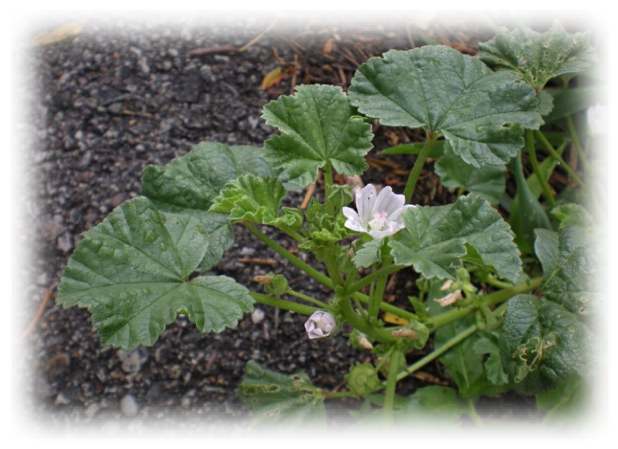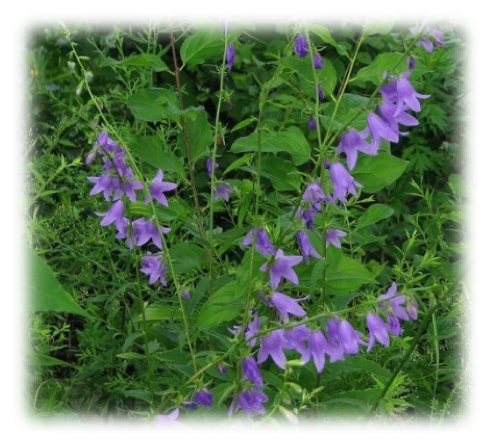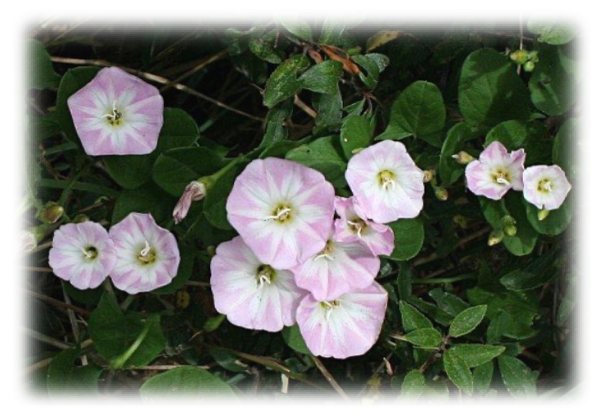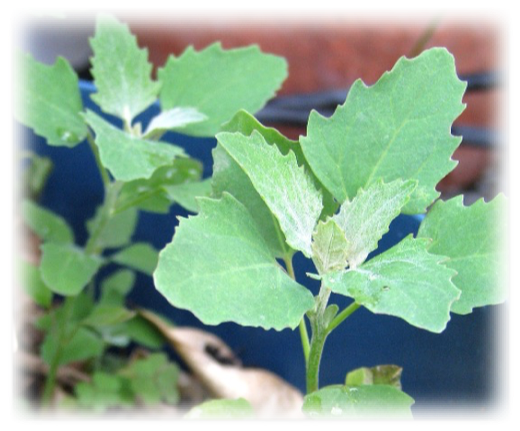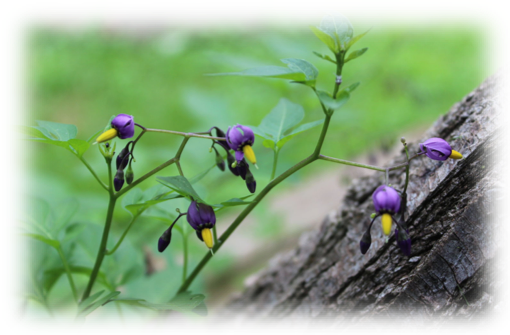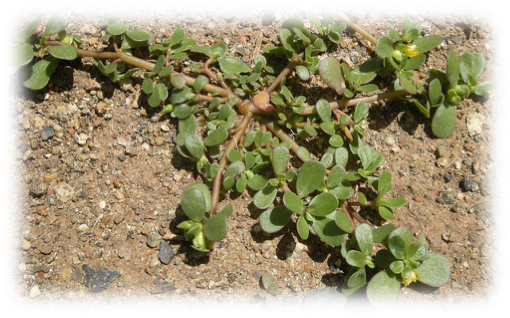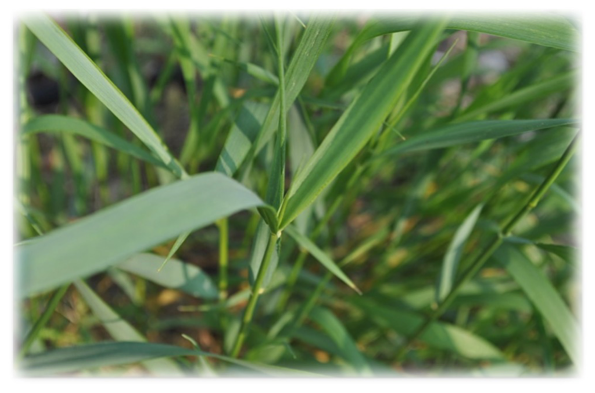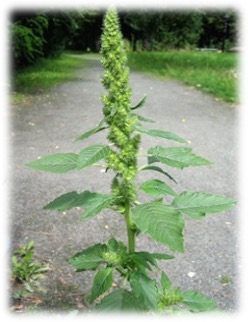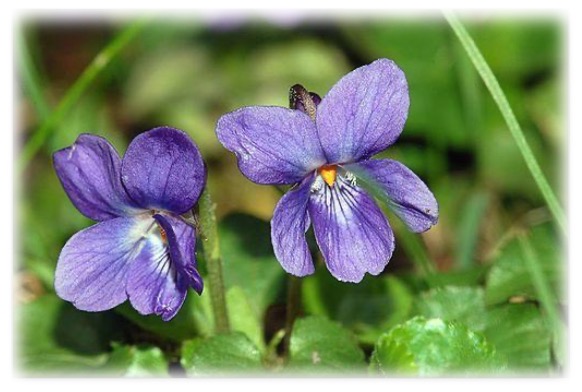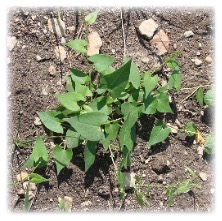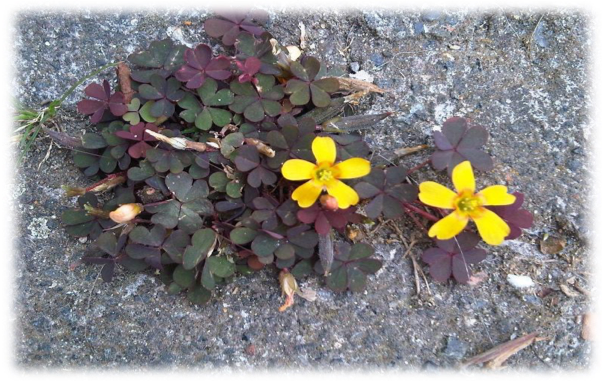WHAT'S THAT WEED? SERIES
The Miriam Webster dictionary defines a weed as “a plant that is not valued where it is growing and is usually of vigorous growth, especially: one that tends to overgrow or choke out more desirable plants.”
As is the case with countless other subject areas, beauty is always in the eye of the beholder. What’s undesirable for a gardener may be desirable for a pollinator or a herbalist.
IN THIS SERIES we will look at different types of common garden weeds - native/non-native, invasive and/or noxious, annual, or perennial. Why? Because understanding the differences in a weed's specific characteristics and growing conditions is essential for weed management.
Posters of each of the following common garden weeds are included as .pdf documents at the end of this page.
- Common Mallow
- Creeping Bellflower
- Dandelion
- Field Bindweed
- Lamb's Quarters
- Nightshade
- Purslane
- Quackgrass
- Redroot Pigweed
- Violets
- Wild Buckwheat
- Wood Sorrel
COMMON MALLOW
HOW TO IDENTIFY?
- Low-growing plant.
- Leaves are circular and ruffled with slightly toothed edges.
- Leaf veins meet at a central point at the stem.
- Taproots have branching fibrous roots attached.
- Flowers are small, white, pink/purple.
- Not easy to pull from the ground.
IS IT A PROBLEM?
- YES. It’s an edible plant, but it competes with other plants and is difficult to weed (its strong fibrous roots cling to the soil).
HOW DOES IT GROW?
- Can be an ANNUAL, BIENNIAL, or PERENNIAL.
- May stay green during the winter.
- Grows in bare patches in lawns, garden beds, and neglected areas.
- Spreads by seeds, which can survive for DECADES in the soil.
HOW TO CONTROL?
- Try to remove it when it is still small.
- Wait for it to rain, or water the ground before weeding.
- Use weeding tools to get out as much of the roots as you can.
- Mature mallow can be dug out with a shovel.
- Don’t let it flower
- To keep seeds from sprouting, avoid disturbing the ground, and cover the ground with mulch.
Sources:
E-Flora BC: Electronic Atlas of the Flora of British Columbia. Malva neglecta Royer, F. and Dickinson, R. Weeds of Canada and the Northern United States. 1999.
Ontario Weeds: Common Mallow. Ontario Ministry of Agriculture, Food, and Rural Affairs.
Image: Cbaile19, CC0, via Wikimedia Commons
CREEPING BELLFLOWER
WHAT DO THEY LOOK LIKE?
- Leaves have different shapes – some heart-shaped with toothed edges and others much longer.
- Multiple pretty purple flowers grow on a long upright stem, dangling from it like bells.
IS THIS PERENNIAL A PROBLEM?
- YES. The leaves, flowers and tubers are edible.
- The flowers are pretty. BUT they will TAKE OVER garden beds and lawns.
HOW DO THEY GROW?
- Have thin roots, but below the roots is a system of thick underground STORAGE TUBERS; new plants can grow from tubers or pieces of roots/tubers.
- Send out roots sideways to create more plants – spread into dense mats that crowd out other plants.
- A single plant can produce THOUSANDS of seeds!
- Can grow in WET or DRY soil and in SUN or SHADE.
HOW TO CONTROL CREEPING BELLFLOWER?
- New Plants can be successfully removed – make sure to get ALL the roots!
- Established plants can be managed or killed:
- To manage, remove NEW LEAVES and FLOWERS as soon as they appear.
- Plant dense groundcovers to compete with the bellflower; cover seeds with mulch.
- To kill, dig out entire bed (get all the roots). Replace with fresh soil and wash the roots of plants you return to the garden. Remove regrowth from pieces of stray roots.
OR cover with cardboard and thick mulch (it can take several years to kill it this way).
FACTS…
- Considered an invasive weed in Alberta
- Native species of campanula can be found in the wild areas surrounding Kamloops – look for purple bell-shaped flowers.
- If you like how it looks, plant other, non-aggressive species of campanula such as campanula persicifolia (peach-leaved bellflower) or campanula carpatica.
Sources:
Alberta Invasive Species Council. Creeping Bellflower. abinvasives.ca
Ontario Ministry of Agriculture, Food and Rural Affairs. Ontario Weeds: Creeping Bellflower.
Royer, F. and Dickinson, R. Weeds of Canada and the Northern United States. 1999.
Image: Robertson, Gordon E. Wiki Commons.
DANDELION 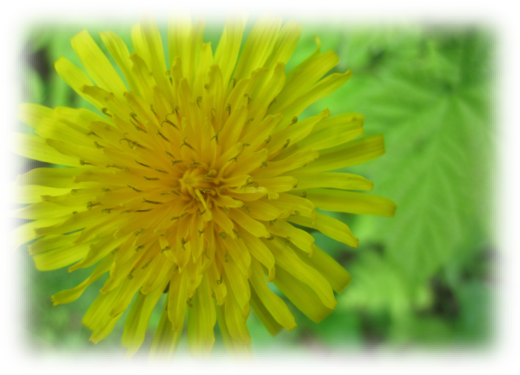
HOW TO IDENTIFY?
- YOU KNOW what they look like
HOW DO THEY GROW?
- Long, deep taproots.
- Spread by SEED.
- Prefer sun and infertile, compact soil.
ARE THEY A PROBLEM?
YES
- Compete with other plants for space and moisture.
- Seeds blow into other areas including neighbours’ yards.
- A WILDFLOWER garden is a BETTER source of pollen for bees.
- Some people find them unattractive.
NO
- Improve soil by breaking it up/aerating it.
- Deep taproots bring nutrients to the surface and make them available to other plants.
- Early source of pollen for bees (but
low in protein and not that nutritious).- All parts are edible but BE AWARE:
- There are other plants with similar leaves – make sure you’re eating the correct plant.
- Dandelions contain latex and some people are allergic.
- Can be fed to livestock (including backyard hens).
- Some people find them attractive.
HOW TO CONTROL?
- Maintain a healthy lawn.
- Vacuum seeds with shop-vac.
- Individual dandelions can be WEEDED – make sure to get as much of the taproot as possible.
- Weed when soil is moist; use a long, thin weeding tool to loosen soil around root.
- Cover LARGE AREAS with cardboard and mulch.
Sources:
Parish, Coupe, and Lloyd. Plants of the Southern Interior and Inland Northwest, 1996.
Royer, F. and Dickinson, R. Weeds of Canada and the Northern United States. 1999.
Sims, C. My Yearly Dandelion Spring Rant. Halton Region Master Gardeners, 29 March 2022.
https://haltonmastergardeners.com/2022/03/29/my-yearly-dandelion-spring-rant/
Image: Estelle Bérubé
FIELD BINDWEED
WHAT DOES IT LOOK LIKE?
- Stems are slender vines that grow along the ground until they find something to climb.
- Leaves are shaped like arrow-heads and look like morning glory flowers
IS THIS PERENNIAL A PROBLEM?
- YES – It aggressively chokes out other plants!
- It can pull down branches of small trees, smother shrubs, twine around perennials/ vegetables and take over lawns.
HOW DOES IT GROW?
- Spreads by roots (5+ metres
long) and seeds.- Likes FULL SUN and POOR SOIL.
- Can survive DROUGHT and FIRE.
HOW TO DEAL WITH IT?
- WEED, WEED, WEED! Be sure to get as many of the roots as you can!
- Repeatedly remove vines below the root crown to eventually wear out the roots.
- Prevent the plants from FLOWERING and GOING TO SEED.
- Improve soil with organic matter.
- Mulch and/or plant aggressive groundcover plants.
- Plant large shade trees.
Source:
Province of British Columbia and the Invasive Species Council of BC. Field Guide to Noxious
Weeds and Other Selected Noxious Plants of British Columbia, Tenth Ed., 2019.
Province of British Columbia. Guide to Weeds in British Columbia, 2002.
Ontario Weed Committee 2022, weedinfo.ca
Image: Tony Atkin, Wiki Commons
LAMB'S QUARTERS
HOW TO IDENTIFY?
- New growth and the underside of older leaves dusted with mealy white powder.
- Leaves usually have WAVY or JAGGED edges and can be different shapes.
- Flowers are small, green, and have no petals.
- Stem is upright with MANY branches.
- Plants are EASY to pull out.
IS THIS ANNUAL PLANT A PROBLEM?
- YES. It’s an edible plant (cook it like spinach) that’s sometimes grown as an agricultural crop.
- BUT it spreads QUICKLY, competes with other plants and uses a lot of water.
- In some conditions it can accumulate HIGH LEVELS of nitrates, oxalates, or sulphates and become toxic to livestock.
HOW DOES IT GROW?
- Has short, branched taproots.
- Each plant has about 72,000 seeds!
- Seeds can survive for 40 YEARS but will only grow if they are near the soil surface.
- Grows in DISTURBED soil in sunny places.
- Often found in vegetable gardens.
HOW TO CONTROL?
- It’s EASY to kill by weeding or hoeing.
- Don’t let it go to seed.
- Cover seeds with mulch and leave them buried – DON’T till the soil.
Sources:
Colorado State University. Guide to Poisonous Plants.
Royer, F. and Dickinson, R. Weeds of Canada and the Northern United States. 1999.
Weedinfo.ca: Lamb’s-quarters, Ontario Weed Committee, 2022.
Image: https://creativecommons.org/licenses/by-sa/3.0>, via Wikimedia Commons
NIGHTSHADE
The nightshade family includes tomatoes, peppers, potatoes, and eggplants. Atropa belladonna, or deadly nightshade, is NOT a common weed in British Columbia. Several different nightshade weeds are found in Kamloops.
HOW TO IDENTIFY?
BITTERSWEET NIGHTSHADE (Solanum dulcamara)
- Climbing vine up to 3 metres long.
- A perennial in zones 4 and warmer.
- Leaves are egg-shaped with two small lobes at the base. They have an unpleasant odour when crushed.
- Clusters of berries are BRIGHT RED when ripe.
- Grows best in disturbed, moist soil.
- Long underground roots can send up new plants.
- TOXIC to people and animals, though some parts of the plant are used medicinally. The UNRIPENED BERRIES are especially POISONOUS.
TO CONTROL
- Wear gloves when handling and hand-pull if you can get all the roots.
- Can be covered with landscape fabric for at least two years to kill it.
BLACK NIGHTSHADE (Solanum nigrum; Solanum americanum)
- Annual or short-lived perennial that grows upright (not a vine).
- Prefers high-nitrogen soils (look for it in your vegetable garden).
- Leaves are oval to triangular, and have smooth or wavy edges.
- Star-shaped flowers are white with yellow centres. Berries are black when ripe.
- Black nightshade can be edible, but REQUIRES THOROUGH RESEARCH before eating because it can also be POISONOUS.
- UNRIPE BERRIES ARE POISONOUS to people and animals.
TO CONTROL
- Hand pull. Don’t let it go to seed!
Sources:
British Columbia Ministry of Agriculture, Food, and Fisheries. Guide to Weeds in British Columbia. 2002 Edmonds, J., and James Chweya. Black Nightshades: Solanum Nigrum L. and Related Species. International Plant Resources Institute, 1997.
Image:
Dellarice, CC BY-SA 4.0 <https://creativecommons.org/licenses/by-sa/4.0>, via Wikimedia Commons Hodnett, R. CC BY-SA 4.0 <https://creativecommons.org/licenses/by-sa/4.0>, via Wikimedia Commons Calimo, CC BY-SA 3.0, https://commons.wikimedia.org/w/index.php?curid=22047682
PURSLANE
HOW TO IDENTIFY?
- It’s a succulent plant with thick,
rounded leaves and reddish stems
that can store water.- It grows horizontally on the ground, forming a dense, circular mat.
- Flowers are small and only open on
SUNNY MORNINGS.- Looks similar to spurge, which is poisonous.
IS THIS ANNUAL A PROBLEM?
- NO. It is very nutritious, with high levels of omega-3 fatty acids, anti-oxidants, vitamins and minerals.
- Can be added to salads, sauteed like spinach, or used in soups and stews (it will thicken stews).
- Has a slightly lemony flavour and is less bitter than many other edible weeds.
- If fed to chickens it will increase the omega-3 fatty acids in their eggs.
- YES. It spreads aggressively – one plant can produce up to 240,000 seeds!
HOW DOES IT GROW?
- Seeds need light and temperatures over 24C to germinate.
- Grows in almost any soil and is drought tolerant.
- Likes DISTURBED soil and full sun (doesn’t grow in shade).
- Seeds can remain viable in the soil for up to 40 YEARS!
- Can grow new plants from pieces of stem.
HOW TO CONTROL?
- Hoeing and tiling may not help because pieces of purslane will grow into new plants.
- Hand-pull it when young, making sure to get all the roots.
- MULCH INSTEAD of tilling, to prevent new seeds from germinating.
Sources:
Kampman, M. Master Gardeners: Many consider purslane a weed, but it’s a powerhouse of nutrition.
Marin Independent Journal. July 19, 2018.
Royer, F. and Dickinson, R. Weeds of Canada and the Northern United States. 1999.
Image: Ethel Aardvark, CC BY 3.0 <https://creativecommons.org/licenses/by/3.0>, via Wikimedia Commons
QUACKGRASS
HOW TO IDENTIFY?
- Grass blades are wide and feel slightly rough.
- Roots are yellowish-white with fibrous roots attached.
- Likely taller than other grasses.
IS THIS PERENNIAL A PROBLEM?
- YES. It spreads aggressively and chokes out other plants.
- Livestock can eat it, but it’s a troublesome weed in gardens.
- Can spread 3 metres a year!
HOW DOES IT GROW?
- Usually in clumps.
- Can grow from seeds.
- Roots spread horizontally.
- Doesn’t like shade.
- Likes moisture and disturbed soil, but is DROUGHT TOLERANT.
- Roots form mats, but don’t grow as deep as some other weeds.
HOW TO CONTROL?
- COVER well with layers of cardboard, old leaves, mulch; weed out any quackgrass that makes its way through the layers.
- Kill small patches with HOT WATER.
- Can be successfully controlled if weeded REPEATEDLY. Make sure to get all the roots because small pieces of root can grow new plants.
- Where appropriate, plant shrubs or trees to create shade.
- To combat in lawns, maintain healthy lawn and overseed.
- Carefully timed and repeated tilling can work, BUT tilling can increase problems.
Sources:
British Columbia Ministry of Agriculture, Food, and Fisheries. Guide to Weeds in British Columbia, 2002.
Royer, F. and Dickinson, R. Weeds of Canada and the Northern United States. 1999.
Parish, Coupe, and Lloyd. Plants of the Southern Interior and Inland Northwest, 1996.
Image: New York State IPM Program at Cornell University, via Wikimedia Commons.
REDROOT PIGWEED
HOW TO IDENTIFY?
- Young plants are reddish-purple on the underside of leaves, and at the base of stems.
- Has clusters of non-descript, green, bristly flower spikes, up to 20cm long.
- Pink or reddish taproot.
- Upright stems grow up to a metre tall, with angular branches.
IS THIS ANNUAL PLANT A PROBLEM?
- YES. It’s an edible plant in the Amaranth family. BUT spreads QUICKLY and competes with other plants.
- In some conditions it can accumulate HIGH LEVELS of nitrates or oxalates, and become toxic to livestock.
- Can cause allergic reactions.
HOW DOES IT GROW?
- Often found near lamb’s quarters.
- Grows in full sun in disturbed, moist, fertile soil.
- Seeds need light and a 15°C soil temp.
- Frequently grows in vegetable gardens; rarely found in lawns.
- Spreads by seed — typically produces between 10,000 and 30,000 seeds.
- Seeds can live in soil for up to 40 YEARS.
HOW TO CONTROL?
- It’s EASY to kill by weeding when young.
- Don’t let it go to seed.
- Cover seeds with mulch and leave them buried – DON’T till the soil.
Sources:
Colorado State University. Guide to Poisonous Plants.
Province of British Columbia. Guide to Weeds in British Columbia, 2002.
Royer, F. and Dickinson, R. Weeds of Canada and the Northern United States, 1999.
Image: Lynk media, CC BY-SA 3.0 <https://creativecommons.org/licenses/by-sa/3.0>, via Wikimedia Commons
VIOLETS
WHAT DO THEY LOOK LIKE?
- Low growing plants with heart-shaped leaves and five-petalled flowers.
- Flowers are usually purple, but can also be white.
- Often grow in CLUMPS.
ARE PERENNIAL VIOLETS A PROBLEM?
YES
- Spread with enthusiasm.
- Not as aggressive as most problem weeds, BUT will compete with other plants.
- Get into lawns.
- Are difficult to get rid of.
NO
- Are a useful groundcover plant.
- Have pretty flowers and a lovely scent.
- Are a GOOD early flower for POLLINATORS.
- FLOWERS and LEAVES are edible –can be added to salads, and leaves can be cooked like spinach.
- Can be worn in a wreath around the neck to prevent drunkenness (though NOT scientifically proven)
HOW DO THEY GROW?
- Spread by SEEDS and also by short horizontal root runners.
- Prefer SHADY, MOIST areas, but can spread to other areas.
HOW TO DEAL WITH VIOLETS?
- WEED unwanted violets – make sure to get ALL the roots!
- DO NOT let them start SPREADING where you don’t want them.
- Large areas of unwanted violets can be covered with PLASTIC to kill them.
- Maintain a HEALTHY lawn.
Sources:
Parish, R., Coupe, R., and Lloyd, D. Plants of the Southern Interior British Columbia and the Inland Northwest, 1996.
Cornell University. Growing Guide, Sweet Violet. www. gardening.cornell.edu/homegardening/scenef803.html
Master Gardeners of Ontario Facebook Page. Violets – Friend or Foe?
www.mgoi.ca/resources/Gardening-FAQs/Violets-Friend-or-Foe.pdf
Image: Fritz Geller-Grimm, CC – Wiki Commons
WILD BUCKWHEAT
Wild buckwheat is sometimes called black bindweed and is OFTEN CONFUSED with field bindweed. Both have arrow-shaped leaves and vines that grow along the ground and twist around other plants.
HOW TO TELL THE DIFFERENCE BETWEEN THE TWO?
WILD BUCKWHEAT (Annual)
- Likes partial shade.
- Pointier leaf tips.
- Spreads by seed.
- Very small, greenish flowers with no petals.
- Thin, short, black roots.
- Easy to pull the roots.
FIELD BINDWEED (Perennial)
- Likes sun.
- Rounder leaf tips.
- Spreads by seeds and roots.
- Small, white ‘morning glory’ flowers.
- Very long, white roots.
- Difficult to pull the roots.
HOW TO CONTROL WILD BUCKWHEAT?
- It’s much easier to manage than field bindweed.
- Seedlings are easy to kill by hoeing or covering with mulch.
- Can kill long vines by cutting the stem at the base of the plant.
- Don’t let it flower and go to seed — if it does there will be many, many new seedlings in the spring.
Sources:
Hartzler, B. and Vittetoe, R. Wild Buckwheat. Iowa State University Extension and Outreach.
https://crops.extension.iastate.edu/encyclopedia/wild-buckwheat
Royer, F. and Dickinson, R. Weeds of Canada and the Northern United States, 1999.
Image: Langton Alicia, U.S. Fish and Wildlife Service, Public domain, via Wikimedia Commons.
WOOD SORREL
HOW TO IDENTIFY?
- Each leaf has 3 heart-shaped leaflets.
- Leaflets fold in half at night or when stressed.
- Small yellow flowers with five petals.
- Often confused with BLACK MEDIC or CLOVER – these don’t have heart-shaped leaflets.
HOW DOES IT GROW?
- An annual in most parts of Canada; a short-lived perennial in parts of BC.
- Mainly spreads by seed. Seed capsules EXPLODE, scattering seed up to two
metres away! Seeds need light to germinate.- Stems can also root at the nodes.
- Likes moist soil and partial shade and often grows through other plants (it’s hard to spot).
- Found in lawns, gardens, and greenhouses.
IS IT A PROBLEM?
- NO. It’s an edible weed, with a slightly sour, lemony flavour.
- It’s high in vitamin C.
- BUT BE AWARE that it (like spinach and
many other edible plants) contains oxalic acid.- It should NOT be consumed in LARGE QUANTITIES by people or livestock, especially people with kidney stones, rheumatism, or gout.
- YES. It spreads aggressively and competes with other plants.
HOW TO CONTROL?
- Hand pull it, making sure to get all the roots.
- OVERSEED lawns.
- Cover the ground in gardens with mulch, to prevent seeds from germinating.
- In new garden beds, soil solarization can be used to control it.
Sources:
Royer, F. and Dickinson, R. Weeds of Canada and the Northern United States. 1999 University of California Statewide Integrated Pest Management Program Agriculture and Natural Resources. Pest Notes: Creeping Wood Sorrel and Bermuda Buttercup. June 2010.
Image: Emőke Dénes. CC BY-SA 4.0, https://commons.wikimedia.org/windex.php?curid=21915084
| Attachment | Size |
|---|---|
| COMMON MALLOW.pdf | 305.47 KB |
| CREEPING BELLFLOWER.pdf | 260.46 KB |
| DANDELION.pdf | 256.81 KB |
| FIELD BINDWEED.pdf | 190.17 KB |
| LAMB'S QUARTERS.pdf | 286.66 KB |
| NIGHTSHADES.pdf | 94.31 KB |
| PURSLANE.pdf | 100.76 KB |
| QUACKGRASS.pdf | 89.52 KB |
| REDROOT PIGWEED.pdf | 294.15 KB |
| VIOLETS.pdf | 247.16 KB |
| WILD BUCKWHEAT.pdf | 96.67 KB |
| WOOD SORREL.pdf | 101.26 KB |
